
The product becomes the medium
by Fraunhofer IPK, VDI and CONTACT Software
The product becomes the medium
by Fraunhofer IPK, VDI and CONTACT Software
The current IoT study "Smart Industrial Products" by CONTACT Software, the Fraunhofer IPK and the VDI shows the high significance of smart products in German industry. At the same time, it illustrates the expectations and challenges of manufacturers due to changing business models and IT requirements.
Smart products are a central topic for German industry - regardless of the sector. This is shown by the current study "Smart Industrial Products 2019", which is now being presented by CONTACT Software together with the Fraunhofer Institute for Production Systems and Design Technology (IPK) and the Association of German Engineers (VDI).
According to the survey, 87 percent of those surveyed said they were already working on the topic. Almost half of them already operate smart products. This result also reflects the growing number of smart products on the market. Smart products are on the corporate agenda for a variety of reasons.
New service models
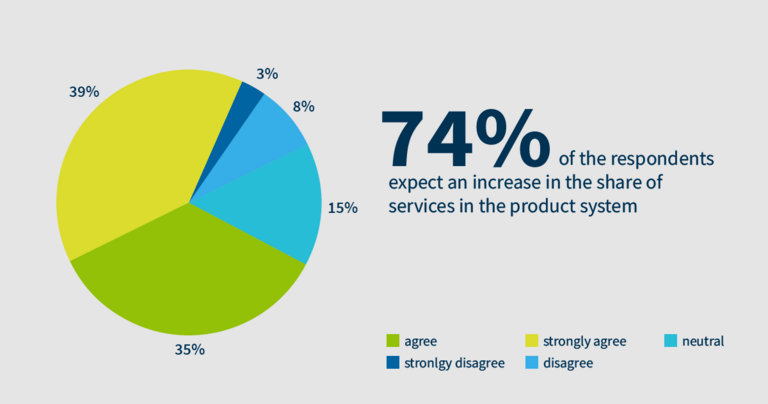
74 percent of the companies surveyed expect that the introduction of smart products will increase the range of the portfolio. Companies that already operate smart products confirm this development: software components and product-related services are increasingly coming to the fore here. Variations are thus easier to implement than with classic hardware.
New service models
74 percent of the companies surveyed expect that the introduction of smart products will increase the range of the portfolio. Companies that already operate smart products confirm this development: software components and product-related services are increasingly coming to the fore here. Variations are thus easier to implement than with classic hardware.
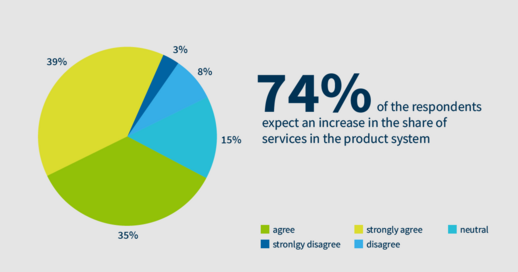
74 percent of the companies surveyed expect that the introduction of smart products will increase the range of the portfolio. Companies that already operate smart products confirm this development: software components and product-related services are increasingly coming to the fore here. Variations are thus easier to implement than with classic hardware.
Create incentives for data usage
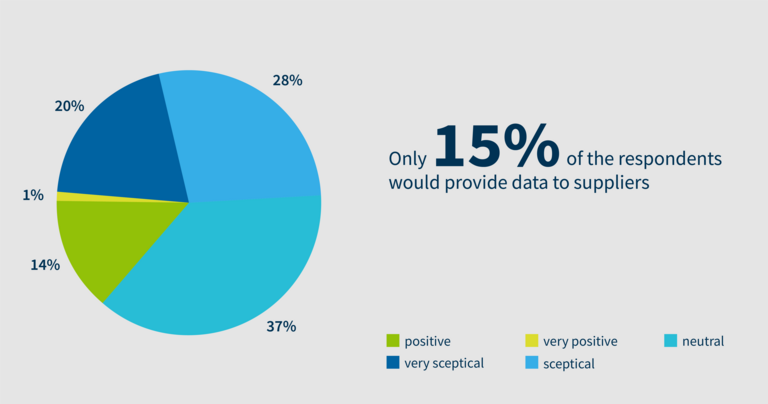
Smart products deliver a large amount of product-related data with a high level of detail. These offer the opportunity to optimize product-related processes and services, both for products already in use and for subsequent product generations. This is a great added value for companies, but passing on the data is often a major hurdle. The willingness to make data available to customers and suppliers is very low. Incentives must be created here so that the full potential of smart products can be leveraged comprehensively.
Create incentives for data usage
Smart products deliver a large amount of product-related data with a high level of detail. These offer the opportunity to optimize product-related processes and services, both for products already in use and for subsequent product generations. This is a great added value for companies, but passing on the data is often a major hurdle. The willingness to make data available to customers and suppliers is very low. Incentives must be created here so that the full potential of smart products can be leveraged comprehensively.
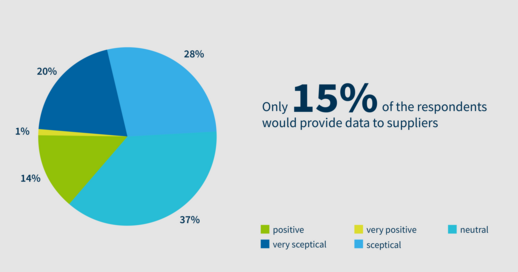
Smart products deliver a large amount of product-related data with a high level of detail. These offer the opportunity to optimize product-related processes and services, both for products already in use and for subsequent product generations. This is a great added value for companies, but passing on the data is often a major hurdle. The willingness to make data available to customers and suppliers is very low. Incentives must be created here so that the full potential of smart products can be leveraged comprehensively.
Stronger customer relations
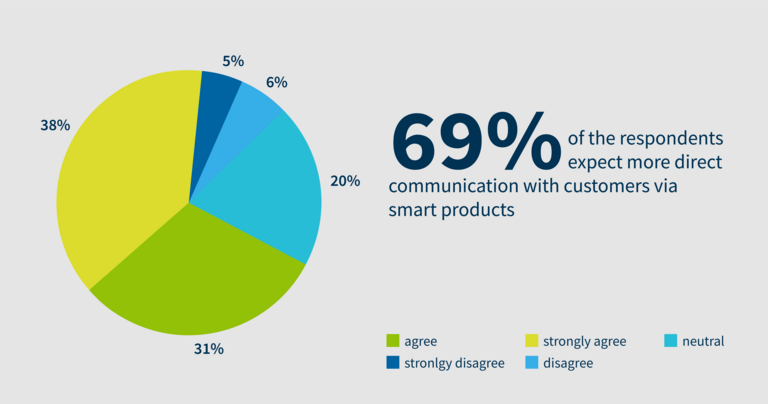
Products play a central role in the relationship between companies and their customers. The product itself becomes the medium. With the addition of services, communication with the customer also changes significantly. The expectation of the companies surveyed that this will result in more direct communication with customers was confirmed by 69 percent.
Stronger customer relations
Products play a central role in the relationship between companies and their customers. The product itself becomes the medium. With the addition of services, communication with the customer also changes significantly. The expectation of the companies surveyed that this will result in more direct communication with customers was confirmed by 69 percent.
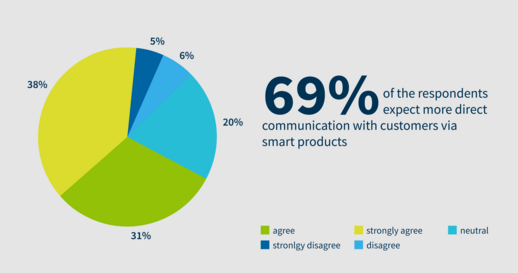
Products play a central role in the relationship between companies and their customers. The product itself becomes the medium. With the addition of services, communication with the customer also changes significantly. The expectation of the companies surveyed that this will result in more direct communication with customers was confirmed by 69 percent.
Customized offers
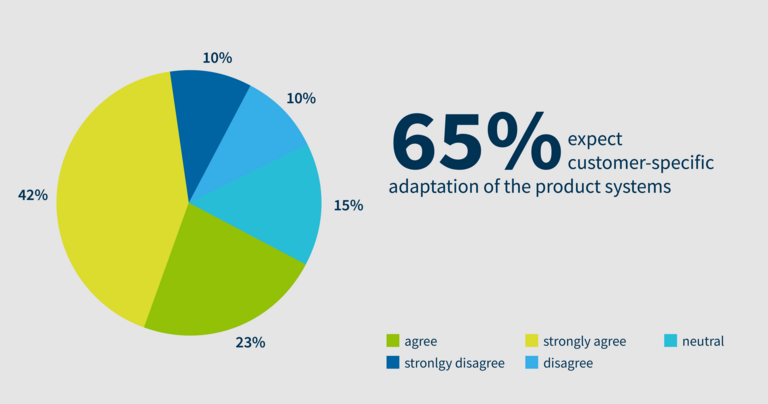
Consumer systems, above all the smartphone, spoil their users with individualized services, information and assistance. Customers expect a high degree of personalization of services in both the B2B and B2C sectors. Accordingly, adaptations to customer requirements in other sectors will also increase. This can be achieved by different approaches: by customizing for the individual customer, for a customer group or by changing the entire product portfolio. It is interesting to note that, according to the results, the mechanical and plant engineering sector is very positive about customer-specific adjustments. On the other hand, however, it is clearly more sceptical about adaptations to series or applications.
Customized offers
Consumer systems, above all the smartphone, spoil their users with individualized services, information and assistance. Customers expect a high degree of personalization of services in both the B2B and B2C sectors. Accordingly, adaptations to customer requirements in other sectors will also increase. This can be achieved by different approaches: by customizing for the individual customer, for a customer group or by changing the entire product portfolio. It is interesting to note that, according to the results, the mechanical and plant engineering sector is very positive about customer-specific adjustments. On the other hand, however, it is clearly more sceptical about adaptations to series or applications.
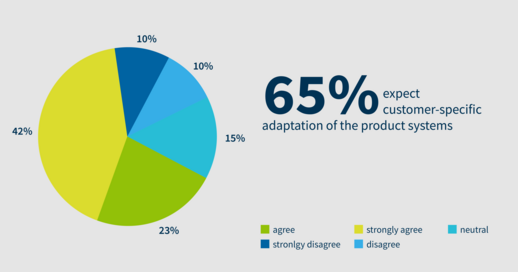
Consumer systems, above all the smartphone, spoil their users with individualized services, information and assistance. Customers expect a high degree of personalization of services in both the B2B and B2C sectors. Accordingly, adaptations to customer requirements in other sectors will also increase. This can be achieved by different approaches: by customizing for the individual customer, for a customer group or by changing the entire product portfolio. It is interesting to note that, according to the results, the mechanical and plant engineering sector is very positive about customer-specific adjustments. On the other hand, however, it is clearly more sceptical about adaptations to series or applications.
Digital Twin as the central element
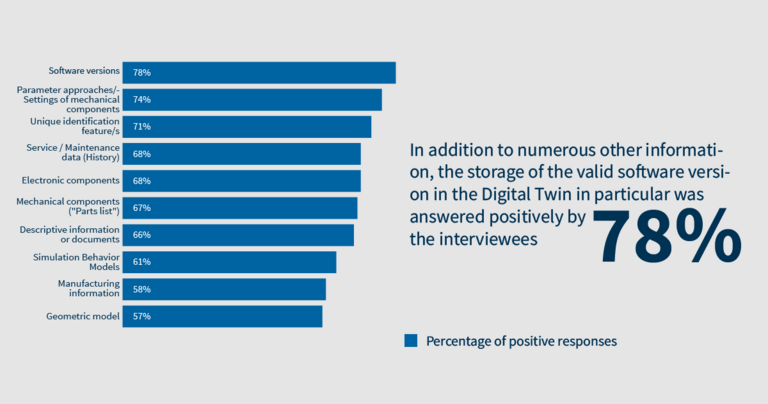
The Digital Twin collects information from all phases of the life cycle (from idea to recycling). The fields of application are broadly diversified. From monitoring and analysis to controlling and mapping the business model, there are countless possible applications. This creates added value in product conception, the design and layout of products and services, for sales and marketing as well as production. Apart from the development data, it is expected that Digital Twins will contain information about the product-specific software version, identifiers, product-specific parameters, documentation and parts lists.
Digital Twin as the central element
The Digital Twin collects information from all phases of the life cycle (from idea to recycling). The fields of application are broadly diversified. From monitoring and analysis to controlling and mapping the business model, there are countless possible applications. This creates added value in product conception, the design and layout of products and services, for sales and marketing as well as production. Apart from the development data, it is expected that Digital Twins will contain information about the product-specific software version, identifiers, product-specific parameters, documentation and parts lists.
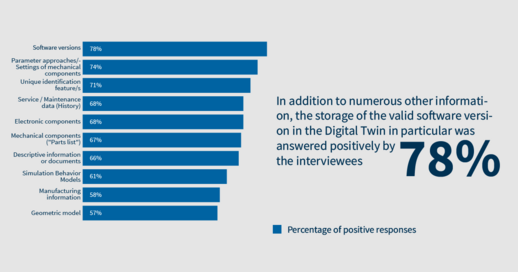
The Digital Twin collects information from all phases of the life cycle (from idea to recycling). The fields of application are broadly diversified. From monitoring and analysis to controlling and mapping the business model, there are countless possible applications. This creates added value in product conception, the design and layout of products and services, for sales and marketing as well as production. Apart from the development data, it is expected that Digital Twins will contain information about the product-specific software version, identifiers, product-specific parameters, documentation and parts lists.
You can download the short overview as a Management Summary:
The entire study is available to you free of charge in German:

